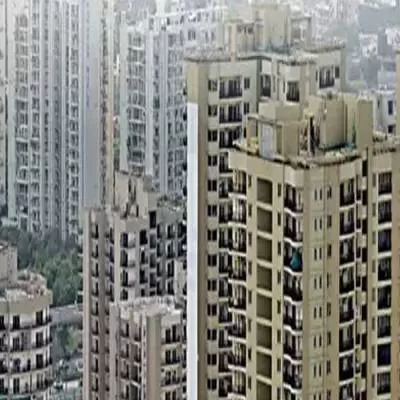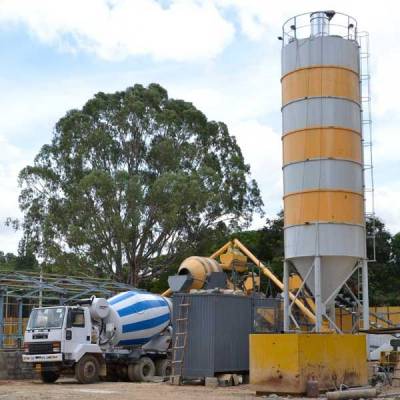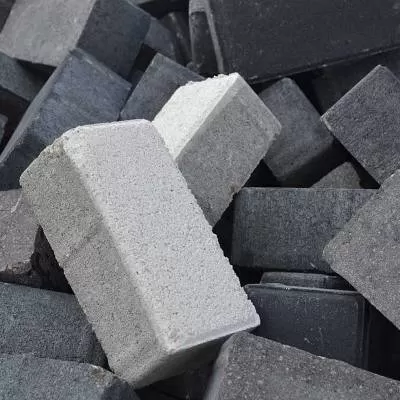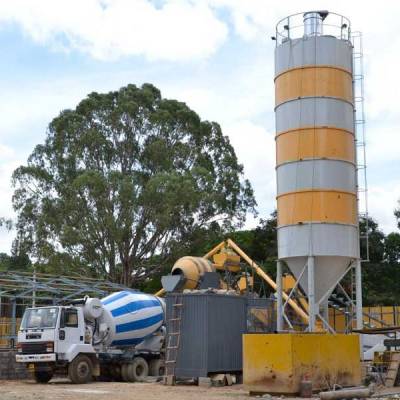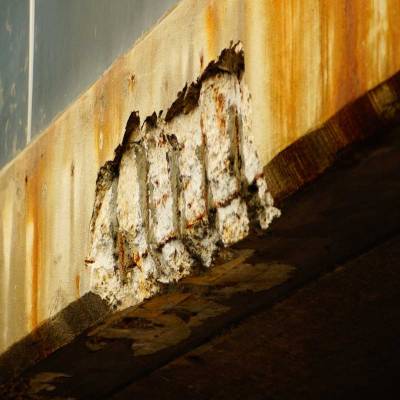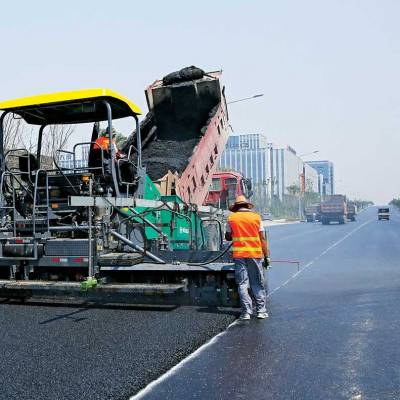- Home
- Building Material
- Concrete
- Concrete Temperature

Concrete Temperature
With mega structures coming up everywhere using high-grade concrete, the control of concrete temperature is become a matter of frequent discussion among civil engineers.
The concern
Green concrete, the nascent stage of concrete hardening, requires a lot of care to mature as good concrete. Concrete is weak in tension bearing; more so, in the initial stage of hardening. Its vulnerability becomes more critical when there are tensile forces induced owing to the hardening process. Being an exothermic reaction, heat is generated during the process; this causes thermal differential and stress that act as a tensile force and cause cracks.
In many cases, cracks developed at the initial stages do not heal and remain or widen further as the concrete shrinks during further hardening. This leads to a situation where structural stability, integrity and durability begin to get compromised. The following observations can be made in the early days of concrete, primarily in the first week:
- Concrete matures with time and temperature.
- Strength comes with maturity.
- In seven days, almost 2/3 of 28 days strength gain for OPC cement-based concrete is expected, though this can vary according to the design mix.
- The exothermic chemical reaction is most active during this period.
- Thermal gain is achieved to its maximum during this period; concrete core temperature starts declining after reaching its peak in most cases.
- Core temperature rise causes thermal differential and stress in concrete.
- The higher the temperature, faster the maturity. But early higher temperature leads to a greater tendency to crack internally, owing to higher thermal stress. Increasing temperature in the early days has shown more strength on the seventh day and less on day 28 compared to standard maturity of concrete on day seven and 28 respectively, owing to thermal micro-cracking.
- Concrete plastic shrinkage and initial shrinkage are more dominant during this period and slow down with time. Late shrinkage can continue for many months but the effect is not so significant as the concrete strength is able to counteract the stress of late shrinkage in most cases.
- Cracks developed during the initial stage owing to plastic shrinkage may not heal automatically in further maturity. On the contrary, at times the crack increases in width, depth or both with time, owing to shrinkage stress acting as a localised tensile force.
- Cracks develop when the tensile stress increases more than the tensile bearing capacity of the concrete.
- If the concrete does not gain sufficient strength during the peak concrete temperature, and specifically during higher thermal differential, there is higher likelihood of cracking.
- The peak temperature of concrete and the thermal differential depends on the green concrete temperature as well as the ambient temperature along with shuttering (temporary formwork) condition.
- The heat gain in the concrete for a given design mix is the same; thus, the green concrete has a direct effect on the heat gain and rise in concrete core temperature. The higher the green concrete temperature, higher the core peak temperature, and vice versa.
- The thermal differential causes the stress in the concrete and core to the surface temperature of the concrete must be kept in controlled condition to control the differential. However, the peak temperature of the core beyond a limit may cause other long-term effects like DEF (delayed ettringite formation; a matter yet to be ascertained codally) and needs to be addressed. In Indian tropical conditions, DEF is not expected to be of serious concern if the temperature is taken care of to limit peak temperature below 70° and pozzolanic material is used in the mix. However, thermal differential of concrete must be an area of focus for durable concrete.
Green concrete temperature
The temperature control limits of green concrete are specified in various codes and they all vary. There are references for RCC green concrete temperature for below 40, up to 38° , up to 32°, up to 30° and up to 25° in various codes, including BIS, BS and ASTM.
With higher grades of concrete, the maximum allowable core temperature restrictions are of higher consideration, which restrict the green concrete temperature less than what is allowed in the codes.
To restrict the peak temperature, the green concrete temperature is asked to be reduced. In such a specific scenario, a holistic approach should be taken to define the green concrete temperature as lowering the temperature is a costly affair - although it is not intended to compromise the strength and durability of the concrete. Care should be taken as green concrete temperature control requires a broader approach than simply lowering the temperature during production; it should first be ascertained whether it is really required. It is more prudent to have higher temperature rather than more thermal differential. Also, the lower temperature should be sustained - not less at any one stage of the concrete production, transportation, placement and construction. Further, thermal consideration of concrete is more important for mass concrete than smaller sections.
Way to set concrete temperature limit
To understand the thermal consideration for a given concrete in a project, a preliminary test should be done to arrive at the initial data. Except generally established limits, at present, the codes have not established the procedure for review and analysis of concrete temperature acceptance for a given scenario. A procedure with the action points mentioned below can be used to logically arrive at a calculation analysis and mock-up review to arrive at the concrete temperature acceptance for the given scenario. Some important questions to ask during calculation analysis and mock-up testing are:
How does the concrete temperature rise with time and when the peak temperature is reached for a given mix? For this, a thermal probe can be inserted before placing the concrete and recoding can be done using a thermal data logger. Alternatively, manual set-up and reading can be done, but manual recoding is tedious. The data can be recorded or plotted and analysed.
What is the design calculation with consideration of thermal stress and the crack width allowed as per the design?
The data can be obtained from the design calculation sheet or designer.
How is the reinforcement as per the design of the structure and is it able to take the stress developed in the concrete owing to thermal stress? The designer can confirm this and reinforcement adequacy for taking additional thermal stress can be checked considering the crack width limitation as per the design calculation.
How is the maturity of concrete and subsequently the strength of concrete with respect to time? The data can be obtained by taking additional sufficient concrete samples and keeping them under standard testing condition. Curing tank temperature can be taken if the temperature is not being maintained in the curing tank. Testing of concrete sampling shall be done as per testing the procedure at various durations.
Is there any crack observed in the mock up and is there is any crack owing to thermal stress and not plastic shrinkage? To avoid plastic shrinkage, the mock shall preferably be for an adiabatic condition for unreinforced, 1 cu m of mass or miniature replica of the actual structure.
Close observation is required to check crack development; if required, a core can be taken to check the inside of the concrete mass. Normally, thermal stress if developed and causing a crack inside, will reflect up to the surface as the surface to core thermal differential is expected to be more than the thermal differential of the core to the other inner part of concrete. Based on a visual examination, the cracks can be checked.
Now, based on the data mentioned above, one can calculate the estimated concrete temperature and acceptable thermal differential. It can also be analysed whether the concrete is expected to crack beyond the design calculation for the given reinforcement design and estimated concrete peak temperature in the project ambient temperature, and more so for the thermal differential. Then, verification can be done by examining the mock-up concrete.
Thus, one can ascertain whether concrete can sustain the expected peak temperature and thermal differential for a given design mix with reinforcement as per design and ambient condition during construction. In case of non-reinforced concrete (PCC-based structure), reinforcement stress bearing will not be present and the concrete would be able to sustain only as much stress as the maturity of concrete will allow.
About the author:
Rupesh Kumar is a Quality Manager and Concrete Technologist with 18 years of experience working in mega projects in India and abroad.
He has dealt with more than 2.5 million cu m of concrete in projects of RMC, hospital, factories, stadium, metros, airports and statue.
RUPESH KUMAR explains why it is important to control concrete temperature and how it can be done. With mega structures coming up everywhere using high-grade concrete, the control of concrete temperature is become a matter of frequent discussion among civil engineers. The concern Green concrete, the nascent stage of concrete hardening, requires a lot of care to mature as good concrete. Concrete is weak in tension bearing; more so, in the initial stage of hardening. Its vulnerability becomes more critical when there are tensile forces induced owing to the hardening process. Being an exothermic reaction, heat is generated during the process; this causes thermal differential and stress that act as a tensile force and cause cracks. In many cases, cracks developed at the initial stages do not heal and remain or widen further as the concrete shrinks during further hardening. This leads to a situation where structural stability, integrity and durability begin to get compromised. The following observations can be made in the early days of concrete, primarily in the first week: Concrete matures with time and temperature. Strength comes with maturity. In seven days, almost 2/3 of 28 days strength gain for OPC cement-based concrete is expected, though this can vary according to the design mix. The exothermic chemical reaction is most active during this period. Thermal gain is achieved to its maximum during this period; concrete core temperature starts declining after reaching its peak in most cases. Core temperature rise causes thermal differential and stress in concrete. The higher the temperature, faster the maturity. But early higher temperature leads to a greater tendency to crack internally, owing to higher thermal stress. Increasing temperature in the early days has shown more strength on the seventh day and less on day 28 compared to standard maturity of concrete on day seven and 28 respectively, owing to thermal micro-cracking. Concrete plastic shrinkage and initial shrinkage are more dominant during this period and slow down with time. Late shrinkage can continue for many months but the effect is not so significant as the concrete strength is able to counteract the stress of late shrinkage in most cases. Cracks developed during the initial stage owing to plastic shrinkage may not heal automatically in further maturity. On the contrary, at times the crack increases in width, depth or both with time, owing to shrinkage stress acting as a localised tensile force. Cracks develop when the tensile stress increases more than the tensile bearing capacity of the concrete. If the concrete does not gain sufficient strength during the peak concrete temperature, and specifically during higher thermal differential, there is higher likelihood of cracking. The peak temperature of concrete and the thermal differential depends on the green concrete temperature as well as the ambient temperature along with shuttering (temporary formwork) condition. The heat gain in the concrete for a given design mix is the same; thus, the green concrete has a direct effect on the heat gain and rise in concrete core temperature. The higher the green concrete temperature, higher the core peak temperature, and vice versa. The thermal differential causes the stress in the concrete and core to the surface temperature of the concrete must be kept in controlled condition to control the differential. However, the peak temperature of the core beyond a limit may cause other long-term effects like DEF (delayed ettringite formation; a matter yet to be ascertained codally) and needs to be addressed. In Indian tropical conditions, DEF is not expected to be of serious concern if the temperature is taken care of to limit peak temperature below 70° and pozzolanic material is used in the mix. However, thermal differential of concrete must be an area of focus for durable concrete. Green concrete temperature The temperature control limits of green concrete are specified in various codes and they all vary. There are references for RCC green concrete temperature for below 40, up to 38° , up to 32°, up to 30° and up to 25° in various codes, including BIS, BS and ASTM. With higher grades of concrete, the maximum allowable core temperature restrictions are of higher consideration, which restrict the green concrete temperature less than what is allowed in the codes. To restrict the peak temperature, the green concrete temperature is asked to be reduced. In such a specific scenario, a holistic approach should be taken to define the green concrete temperature as lowering the temperature is a costly affair - although it is not intended to compromise the strength and durability of the concrete. Care should be taken as green concrete temperature control requires a broader approach than simply lowering the temperature during production; it should first be ascertained whether it is really required. It is more prudent to have higher temperature rather than more thermal differential. Also, the lower temperature should be sustained - not less at any one stage of the concrete production, transportation, placement and construction. Further, thermal consideration of concrete is more important for mass concrete than smaller sections. Way to set concrete temperature limit To understand the thermal consideration for a given concrete in a project, a preliminary test should be done to arrive at the initial data. Except generally established limits, at present, the codes have not established the procedure for review and analysis of concrete temperature acceptance for a given scenario. A procedure with the action points mentioned below can be used to logically arrive at a calculation analysis and mock-up review to arrive at the concrete temperature acceptance for the given scenario. Some important questions to ask during calculation analysis and mock-up testing are: How does the concrete temperature rise with time and when the peak temperature is reached for a given mix? For this, a thermal probe can be inserted before placing the concrete and recoding can be done using a thermal data logger. Alternatively, manual set-up and reading can be done, but manual recoding is tedious. The data can be recorded or plotted and analysed. What is the design calculation with consideration of thermal stress and the crack width allowed as per the design? The data can be obtained from the design calculation sheet or designer. How is the reinforcement as per the design of the structure and is it able to take the stress developed in the concrete owing to thermal stress? The designer can confirm this and reinforcement adequacy for taking additional thermal stress can be checked considering the crack width limitation as per the design calculation. How is the maturity of concrete and subsequently the strength of concrete with respect to time? The data can be obtained by taking additional sufficient concrete samples and keeping them under standard testing condition. Curing tank temperature can be taken if the temperature is not being maintained in the curing tank. Testing of concrete sampling shall be done as per testing the procedure at various durations. Is there any crack observed in the mock up and is there is any crack owing to thermal stress and not plastic shrinkage? To avoid plastic shrinkage, the mock shall preferably be for an adiabatic condition for unreinforced, 1 cu m of mass or miniature replica of the actual structure. Close observation is required to check crack development; if required, a core can be taken to check the inside of the concrete mass. Normally, thermal stress if developed and causing a crack inside, will reflect up to the surface as the surface to core thermal differential is expected to be more than the thermal differential of the core to the other inner part of concrete. Based on a visual examination, the cracks can be checked. Now, based on the data mentioned above, one can calculate the estimated concrete temperature and acceptable thermal differential. It can also be analysed whether the concrete is expected to crack beyond the design calculation for the given reinforcement design and estimated concrete peak temperature in the project ambient temperature, and more so for the thermal differential. Then, verification can be done by examining the mock-up concrete. Thus, one can ascertain whether concrete can sustain the expected peak temperature and thermal differential for a given design mix with reinforcement as per design and ambient condition during construction. In case of non-reinforced concrete (PCC-based structure), reinforcement stress bearing will not be present and the concrete would be able to sustain only as much stress as the maturity of concrete will allow. About the author: Rupesh Kumar is a Quality Manager and Concrete Technologist with 18 years of experience working in mega projects in India and abroad. He has dealt with more than 2.5 million cu m of concrete in projects of RMC, hospital, factories, stadium, metros, airports and statue.


